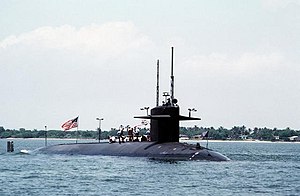| Permit-class submarine | |
|---|---|
 USS Greenling (SSN-614) | |
| Class overview | |
| Builders: |
Portsmouth Naval Shipyard Mare Island Naval Shipyard Ingalls Shipbuilding New York Shipbuilding General Dynamics Electric Boat |
| Operators: |
|
| Preceded by: | Skipjack-class submarine |
| Succeeded by: | Sturgeon-class submarine |
| Built: | 1958–1967 |
| In commission: | 1961–1994 |
| Completed: | 14 |
| Lost: | 1 |
| Retired: | 13 |
| General characteristics | |
| Type: | Fast attack submarine |
| Displacement: |
3,750 long tons (3,810 t) surfaced 4,300 long tons (4,369 t) submerged |
| Length: | 278 ft 5 in (84.86 m) |
| Beam: | 31 ft 7 in (9.63 m) |
| Draft: | 25 ft 2 in (7.67 m) |
| Propulsion: |
1 S5W PWR 2 steam turbines, 15,000 shp (11 MW) 1 shaft |
| Speed: |
15 knots (28 km/h; 17 mph) surfaced 28 knots (52 km/h; 32 mph) submerged |
| Range: | Unlimited, except by food supplies |
| Test depth: | 1,300 ft (400 m) |
| Complement: | 112 |
| Sensors and processing systems: |
BQQ-2 sonar (later BQQ-5) Mark 113 Fire-control system (later Mark 117) Periscopes |
| Electronic warfare & decoys: | ESM |
| Armament: |
• 4 × 21 in (533 mm) torpedo tubes amidships • 12-18 × Mark 37 torpedoes, later replaced by Mark 48s • 4-6 × UUM-44 SUBROC anti-submarine missiles • 4 × UGM-84 Harpoon anti-ship missiles |
The Permit-class submarine, originally known as the Thresher class, was a class of nuclear-powered fast attack submarines (hull classification symbol SSN) in service with the United States Navy from the 1960s until 1994. They replaced the Skipjack class. They were used primarily in the 1960s and 1970s, until replaced by the Sturgeon and Los Angeles classes.
The Permit class resulted from a study commissioned in 1956 by the Chief of Naval Operations (CNO), Admiral Arleigh Burke. In "Project Nobska," the Committee on Undersea Warfare of the United States National Academy of Sciences considered the lessons learned from various prototypes and experimental platforms.
Design[]
The new class kept the proven S5W reactor plant from the immediately preceding Skipjacks, but were a radical change in many other ways. The Threshers had the large bow-mounted sonar and angled, amidships torpedo tubes pioneered by the Tullibee. Although it used the same HY-80 as the Skipjacks, the Threshers' pressure hulls were made using an improved process that extended test depth to 1,300 ft. The engineering spaces were also redesigned, with the turbines supported on "rafts" that were suspended from the hull on sound damping isolation mounts. Their hulls were more effectively streamlined and had smaller sails, but the increased displacement over the Skipjacks lead to top speed of around 28kts, five knots slower than the Skipjacks.
Armament[]
The ships had torpedo launchers moved to the middle of the hull. This made available the required large space in the bow for the BQQ-2, BQQ-5 in modernized boats, sonar system, a new and powerful detection low-frequency sensor. Initially armed with Mark 37 torpedoes, they later carried the improved Mark 48, the UGM-84 Harpoon (replacing four of the Mk-48s) and the UUM-44 SUBROC (replacing six Mk-48s, four after Harpoon was adopted). The maximum weapons load was 23 torpedoes/missiles or, theoretically 46 Mk-57, 60 or 67 mines. Or a mix of mines, torpedoes and missiles.[1]
Construction[]
The first submarine commissioned in this class was the ill-fated Thresher, and so the class was known by her name. When Thresher was lost, the class took the name of the second ship in the class, Permit, and the SUBSAFE program began. SUBSAFE includes specific training of SUBSAFE quality assurance inspectors in the engine room crew, and tracks extremely detailed information about every component of a submarine's engine room that contacts seawater. Joints in any equipment carrying seawater must be welded (not brazed), and every hull penetration larger than a specified size can be quickly shut by a remote hydraulic mechanism.
The engine room of Jack was lengthened by ten feet to accommodate an experimental direct-drive propulsion system using concentric counter-rotating propellers. Although counter-rotating propellers produced impressive gains in speed on the experimental Albacore, in Jack the results were disappointing because of the difficulty in sealing the shaft. Jack was also used to test polymer ejection that could reduce flow noises that degraded sonar performance.
Flasher, Greenling, and Gato were fitted with heavier machinery and a larger sail, to house additional masts, and made ten feet longer than the other units of the class to include more SUBSAFE features, additional reserve buoyancy, more intelligence gathering equipment and improved accommodations.
Boats[]
The gaps in the hull-number sequence were taken by the unique Tullibee, and the George Washington, Ethan Allen, and Lafayette fleet ballistic missile submarine classes.
See also[]
- General Dynamics - Principal class design manufacturer.
References[]
- Robert Hutchinson, Submarines, War Beneath The Waves, From 1776 To The Present Day
- Norman Polmar, Cold War Submarines: The Design and Construction of U.S. and Soviet Submarines
- Karam, P. Andrew, Rig Ship for Ultra Quiet: Life on a nuclear attack boat at the end of the Cold War
Notes[]
- ↑ War Machines Encyclopedia, Aerospace Publishing Ltd., Italian version printed by De Agostini is p.526-527)
External links[]
| Wikimedia Commons has media related to Thresher/Permit class submarines. |
- SSN-594 Permit class at GlobalSecurity.org
| ||||||||
| ||||||||||||||||||||||||||
Warning: Display title "<i>Thresher/Permit</i> class submarine" overrides earlier display title "<i>Permit</i>-class submarine".
The original article can be found at Permit-class submarine and the edit history here.